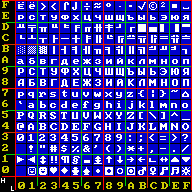Nibble on:
[Wikipedia]
[Google]
[Amazon]
 In
In
 In
In computing
Computing is any goal-oriented activity requiring, benefiting from, or creating computer, computing machinery. It includes the study and experimentation of algorithmic processes, and the development of both computer hardware, hardware and softw ...
, a nibble, or spelled nybble to match byte, is a unit of information that is an aggregation of four- bits; half of a byte/ octet. The unit is alternatively called nyble, nybl, half-byte or tetrade. In networking or telecommunications
Telecommunication, often used in its plural form or abbreviated as telecom, is the transmission of information over a distance using electronic means, typically through cables, radio waves, or other communication technologies. These means of ...
, the unit is often called a semi-octet, quadbit, or quartet.
As a nibble can represent sixteen () possible values, a nibble value is often shown as a hexadecimal
Hexadecimal (also known as base-16 or simply hex) is a Numeral system#Positional systems in detail, positional numeral system that represents numbers using a radix (base) of sixteen. Unlike the decimal system representing numbers using ten symbo ...
digit (hex digit). A byte is two nibbles, and therefore, a value can be shown as two hex digits.
Four-bit computers use nibble-sized data for storage and operations; as the word unit. Such computers were used in early microprocessor
A microprocessor is a computer processor (computing), processor for which the data processing logic and control is included on a single integrated circuit (IC), or a small number of ICs. The microprocessor contains the arithmetic, logic, a ...
s, pocket calculators and pocket computers. They continue to be used in some microcontrollers. In this context, 4-bit groups were sometimes also called characters rather than nibbles.
History
The term ''nibble'' originates from its representing half a byte, with ''byte'' a homophone of the English word ''bite''. In 2014, David B. Benson, a professor emeritus at Washington State University, remembered that he playfully used (and may have possibly coined) the term ''nibble'' as half a byte and unit of storage required to hold a binary-coded decimal (BCD) digit around 1958, when talking to a programmer from Los Alamos Scientific Laboratory. The alternative spelling ''nybble'' reflects the spelling of ''byte'', as noted in editorials of '' Kilobaud'' and '' Byte'' in the early 1980s. Another early recorded use of the term ''nybble'' was in 1977 within the consumer-banking technology group at Citibank. It created a pre- ISO 8583 standard for transactional messages between cash machines and Citibank's data centers that used the basic data unit ''nabble''. ''Nibble'' is used to describe the amount of memory used to store a digit of a number stored in packed decimal format (BCD) within an IBM mainframe. This technique is used to make computations faster and debugging easier. An 8-bit byte is split in half and each nibble is used to store one decimal digit. The last (rightmost) nibble of the variable is reserved for the sign. Thus a variable which can store up to nine digits would be "packed" into 5 bytes. Ease of debugging resulted from the numbers' being readable in a hex dump where two hex numbers are used to represent the value of a byte, as . For example, a five-byte BCD value of represents a decimal value of +314159265. Historically, there are cases where ''nybble'' was used for a group of bits greater than 4. On the Apple II, much of the disk drive control and group-coded recording was implemented in software. Writing data to a disk was done by converting 256-byte pages into sets of 5-bit (later, 6-bit) nibbles and loading disk data required the reverse. Moreover, 1982 documentation for the Integrated Woz Machine refers consistently to an "8 bit nibble". The term ''byte'' once had the same ambiguity and meant a set of bits but not necessarily 8, hence the distinction of ''bytes'' and '' octets'' or of ''nibbles'' and ''quartets'' (or ''quadbits''). Today, the terms ''byte'' and ''nibble'' almost always refer to 8-bit and 4-bit collections, respectively and are very rarely used to express any other sizes.Value representation
A nibble-sized value can be represented in different numeric bases:Low and high nibbles
The low and high nibbles of a byte are its two halves, which are the least and the most significant bits within the byte, respectively. In a graphical representation of bits within a byte, the leftmost bit could represent the most significant bit ( MSB), corresponding to ordinary decimal notation in which the digit at the left of a number is the most significant. In such an illustration, the four bits on the left end of the byte form the high nibble, and the remaining four bits form the low nibble. For example, : the high nibble is (), and the low nibble is (). The total value is ().See also
* * *References
External links
* {{Computer Storage Volumes Computing terminology Data unit Units of information Articles with example C code Articles with example Lisp (programming language) code